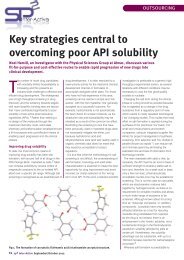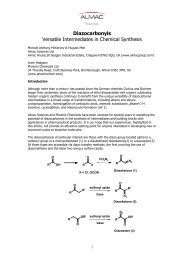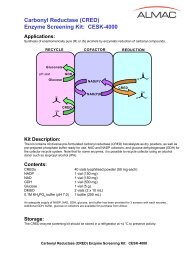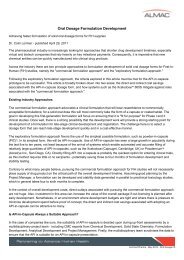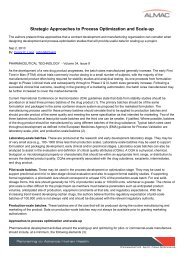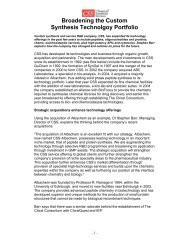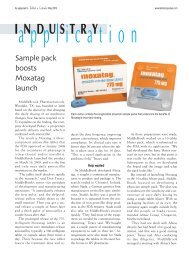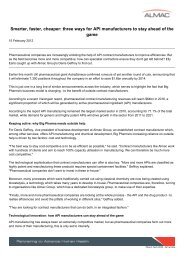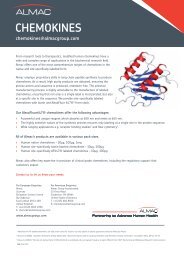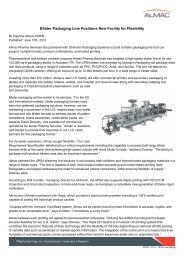Synthetic Strategies for 14C Labelling of Drug Molecules Dr ... - Almac
Synthetic Strategies for 14C Labelling of Drug Molecules Dr ... - Almac
Synthetic Strategies for 14C Labelling of Drug Molecules Dr ... - Almac
- No tags were found...
Create successful ePaper yourself
Turn your PDF publications into a flip-book with our unique Google optimized e-Paper software.
Introduction to 14 Ccpres/v1b/ca/1998-08/ 4
Discovery <strong>of</strong> 14 CMartin Kamen & Sam Ruben (27-FEB-1940)T 1/2 ~ 5730 Years
<strong>14C</strong> Starting Materials
Barium 14 C carbonate staircaseOHCH 3<strong>14C</strong> 6AA<strong>14C</strong>H 14 C<strong>14C</strong>HPEPTIDESHNOH 14 CHO<strong>14C</strong>H 3IMeOC H 3HOMeO<strong>14C</strong> 6<strong>14C</strong>O 214NCH 3OH H143COHN OCu 14 CNK 14 CN<strong>14C</strong> 6 14F 3C C OHClOHOMeOMeOHOHBa 14 CO 3Cl
<strong>14C</strong> Radiotracer• In pharmaceutical research 14 C is used asa tracer to ensure that potential drugs aremetabolized without <strong>for</strong>ming harmful byproducts– ADMET Studies• The 14 C label should ideally <strong>for</strong>m part <strong>of</strong>the compounds molecular skeleton
<strong>14C</strong> <strong>Synthetic</strong> <strong>Strategies</strong><strong>14C</strong>labelling
Target: [ 14 C]XEN-D0401• XEN-D0401 is a novel andselective small moleculeactivator <strong>of</strong> the largeconductancecalciumactivatedpotassiumchannel (known as the BKchannel)• Currently in Phase 1development <strong>for</strong> thetreatment <strong>of</strong> overactivebladder (OAB)F 3CCl*HNOOH* = 14 C LabelOH
<strong>14C</strong> Starting MaterialF 3CHN*OOHOHClMeO*OOO<strong>14C</strong>O 2Cl[ 14 C]XEN-D0401 [ 14 C]-4
Generation <strong>of</strong> ‘<strong>Dr</strong>y’ 14 CO 2HIGH VACUUMPUMPX<strong>14C</strong>O 2(wet)High Vacuum ManifoldP 2O 5c H 2SO 4Ba 14 CO 3<strong>14C</strong>O 2(dry)<strong>14C</strong>O 2Liquid Nitrogen
CarboxylationBrOH1. NaH / DMFBrOOn-BuLi/HexaneLiOOCl2. MOM-ClCl(1) (2)THF-78 o C, 20 minsCllithiated intermediateHOOBa 14 CO 3c H 2SO 4<strong>14C</strong>O 2[ 14 C]-3-196 o C to rt>50 mCi/mmol250 mCiRadiochemical yield = 76%*OOCl
O-MethylationHO*OOOK 2CO 3/ AcetoneCH 3IMeO*OOOCl35 o CCl[ 14 C]-3[ 14 C]-4
ClNH 2CF 3OSTEP 1NHCOt-BuCF 3n-BuLi, Hex, THF-78 o CLiNOLi(5)83%(6)CF 3MeO*OOMOMCl[ 14 C]-4F 3CNHCOt-BuO* OMOMColumn chromatographyClSTEP 271%[ 14 C]-7
S L Kitson, S J Jones et al. J Label Compd. Radiopharm 2010, 53, 140-146NaOHEtOHSTEP 368%F 3CClNH 2O* OMOM[ 14 C]-8OOLiHMDS / THF-20 o C to -10 o CSTEP 4F 3CClHN*[ 14 C]-9OOHOMOMIPA, HCl45 o CColumn ChromatographyF 3CClHN*OOHOHOverall Radiochemical Yield ~ 30%STEP 563%[ 14 C]XEN-D0401* = Carbon-14 label
Key Step: A one pot construction <strong>of</strong> the quinolin-2-onering under strong baseF 3CClHN HO*O[ 14 C]-8OLiHMDS (2eqv)OOcondensationF 3CClOLiOHNLiO*OdianionOLiHMDSF 3CClOLiO-NLiO*OOcyclisationF 3CLiN O*LiOOCltrianionOLiOH 2OF 3CHOHN*OHOOHOLiOH-H 2OdehydrationF 3CClHN*OOOHOCl[ 14 C]-9
Aporphine skeleton‘naturally occurring’213AC4B<strong>14C</strong>6aN56R11710D89Dicentra <strong>for</strong>mosa'Bleeding heart'S L Kitson. J Label Compd Radiopharm; 2007, 50, 290-294S L Kitson. J Label Compd Radiopharm; 2006, 49, 517-531
Structure & Function <strong>of</strong> (R)-(-)-Apomorphine• (R)-(-)-Apomorphine is a potent non-selectiveD 1 /D 2 agonist at the dopamine receptor.• (R)-(-)- Apomorphine (Apokyn) is used tocontrol Parkinson’s disease (D 2 receptor).• (R)-(-)- Apomorphine (Uprima ® ) is used to treaterectile dysfunction (D 1 receptor).• Features:• Contains an ortho-phenol motif.• Tetracyclic carbon skeleton.• Tetrahydroisoquinoline nucleus.• ‘Planar’ structure.• Contains an embedded dopaminepharmacophore.SR
Retrosynthesis <strong>of</strong> ApomorphineHOHOFGIA BN CH3C *MeODMeO(R/S)-[6a- 14 C]Apomorphine dimethyl ether*= 14 CRING CFORMATIONPschorrcouplingMeOADOMeBN*NO 2CH 3Bischler-NapieralskicyclodehydrationRING BFORMATIONMeOMeONO 2D*ON HATetrahydro[ 14 C]isoquinolineN-[carboxyl- 14 C]Acetamide
Synthesis <strong>of</strong> N-[carboxyl- 14 C]acetamideK 14 CN55mCi/mmolNO 2MeODMeO(COCl) 2DMFMeOMeOClNO 2D*OClMeOMeOANO 290% 86%86%(2 steps)NOacid2* hydrolysis MeOCN*OMeONONH 2H2 MeO* NDOMeOOHN-[carboxyl- 14 C]AcetamideARadiochemical yield = 67%
Bischler-Napieralski CyclodehydrationMeOMeONO 2D*OHNAP 2O 5/POCl 3TolueneMeOMeONO 2ND *OPimineAN-[carboxyl- 14 C]AcetamideMeOMeONO 2D*N +-OPAnitrilium saltRING BFORMATIONA*BN +ClHbasic work upA*BNMeODOMeNO 2MeODNO 2OMeDihydro[ 14 C]isoquinolineRadiochemical yield = 43%
N-Methylation Reduction StepMeOOMeNN +CH 3I/THFNO 2* * *I -NaBH 4/EtOHCH 3MeO NO MeO2OMeOMeNNO 2CH 3Dihydro[ 14 C]isoquinoline [ 14 C]Methiodide Tetrahydro[ 14 C]isoquinolineRadiochemical yield = 77%Bischler-NapieralskiEndocyclic Product
Reduction-Pschorr CouplingNCH 3N*CHZn/HCl *310% H 2SO 4DDNaNO 2MeONO 2MeONH 2OMeOMeTetrahydro[ 14 C]isoquinolineA BDNCH 3+MeO N + N HSO-OMe4aryldiazonium salt*PSCHORR COUPLINGCu 2ORING C FORMATIONACMeODMeO*NCH3H(R/S)-[6a- 14 C]Apomorphine dimethyl etherB
Chiral SeparationMeO*N CH3HMeO(R/S)-(+/-)-[6a- 14 C]Apomorphine dimethyl etherHPLC Conditions: Chiralcel OD column, eluting withhexane/propan-2-ol/dimethylamine [950:50:5]MeO*N CH3HSMeO*N CH3HRMeOMeO(S)-(+)-[6a- 14 C]Apomorphine dimethyl etherRadiochemical yield = 11% fromTetrahydro[ 14 C]isoquinoline(R)-(-)-[6a- 14 C]Apomorphine dimethyl etherRadiochemical yield = 16% fromTetrahydro[ 14 C]isoquinoline
(R)-(-)-[6a- 14 C]ApomorphineMeO*N CH3HBBr 3CH 2Cl 2HO*N CH3HMeOHO(R)-(-)-[6a- 14 C]Apomorphine dimethyl ether(R)-(-)-[6a- 14 C]Apomorphine• PLRP-S column (CH 3 CN:HCl aq)• Specific Activity: 55mCi/mmol• Radiochemical purity => 98%• Radiochiral purity => 99%
Combretastatin A-1MeOOHMeOOMeOMeOH• Combretastatin A-1 is a natural productfirst isolated from the African bush willow treein the 1980s• Chemotherapeutic properties by acting on thetumour vasculature, leading to blood flow shutdown and ultimately tumour death
Target: [methyl- 14 C]Combretastatin A-1 diphosphateMeO<strong>14C</strong>H 3OOMe• Treatment <strong>of</strong> solid tumoursOMeO• The pro-drug undergoes in vivo de-phosphorylationto generate the active agent combretastatin A-1OPOOPOHO.2K +OOH
<strong>14C</strong> <strong>Synthetic</strong> routeR T Brown et al. J Label Compd. Radiopharm 2009, 52, 567-570MeOO<strong>14C</strong>H 3ITBAFCH 3CNMeOOTBSOO75%<strong>14C</strong>H 3OOOMeOMeOMeOMeTiCl 4/ DCMMeOOH(BnO) 2P(O)H27%<strong>14C</strong>H 3OOHCCl 4/ CH 3CNOMeOMeDIPEA / DMAP72%MeOOP(O)(OBn) 21. TMSBr / MeCN2. KOMe, MeOH3. HCl/H 2O/EtOHMeOOPOOHO<strong>14C</strong>H 3OOMeOMeOP(O)(OBn) 257%<strong>14C</strong>H 3OOMeOMeOOP.2K +OOH[methyl- 14 C]-Combretastatin A1 diphosphate
[ 14 C]AcetylenesOH<strong>14C</strong>OTarget: [5- 14 C]Hex-5-ynoic acid
[ 14 C]Acetylenes:Ohira Bestmann ReagentMeOMeOOPON +N -CH 3K 2CO 3MeOHrt, 4-16 hMeOMeOOPON +N -OMeCH 3MeOMeOOP-N +N -Ohira-Bestmann ReagentO14R CHR<strong>14C</strong>H
<strong>14C</strong> Acetylene SynthesisBrOHOp-TsOHEtOHBrOTHPK 14 CN, EtOH71 %67 %NC *OTHPDiBAL80 %HO<strong>14C</strong>OTHPON +NOPOMeOMeK 2CO 3, MeOH<strong>14C</strong>OTHPCrO 3, H 2SO 4,H 2O, acetone68 % 74 %Overall Radiochemical Yield 29 % from [ 14 C]KCN<strong>14C</strong>OOH
[ 14 C]ZT-1: a new generation <strong>of</strong> acetylcholinesterase(AChE) inhibitorsL Leman, S L Kitson et al. J. Label Compd. Radiopharm 2011, 720-730CH 3exocyclic E-double bondbicyclo[3.3.1] double bondHNOH 3CCH 3NH 2hydrogen bondHOMeOCH 3N RHNHOactive metabolite, (-)-huperzine Ain vivoprogressive hydrolysis+CHOOHClpyridin-2-one ringClOMePro-drug (-)ZT-1inactive metabolite, 5-chloro-o-vanillin
<strong>14C</strong> SynthesisOHOMOMOMOMNaH/DMFn-BuLiI* * *MOM-ClI 2[ 14 C]-1Step 1 [ 14 C]-2 Step 2 [ 14 C]-3CuBr/DMFNaOMe/MeOHOMOMO OMOMOMe n-BuLiOMeH* *DMFStep 3 [ 14 C]-4 Step 4[ 14 C]-5O OHHCl/MeOH ICl / CHOMe2 Cl 2H*NaHCO 3HOOH*ClOMe* = U- 14 CStep 5[ 14 C]-6Step 6[ 14 C]-7
[ 14 C]-ZT-1OOHC H 3CH 3NH 2HNOH*[ 14 C]-7ClEtOHStep 7OMeC H 3HOMeOCH 3N*HNClO(-)-Huperzine A[ 14 C]-ZT-1
ConclusionWhen designing a 14 C labelled synthesis it is important toconsider the following:• Identify simple starting materials from the barium 14 Ccarbonate ‘staircase’ which are commercially available oralternatively easily made• Plan, develop and execute the synthetic methodology tothe final drug substance. This approach can <strong>of</strong>ten restrictthe position <strong>of</strong> the label in the drug and will cause a changein the drug purity pr<strong>of</strong>ile from the original laboratorysynthesis route• Locate a biologically stable position <strong>for</strong> the 14 C label
<strong>14C</strong> Radiochemistry Laboratory




